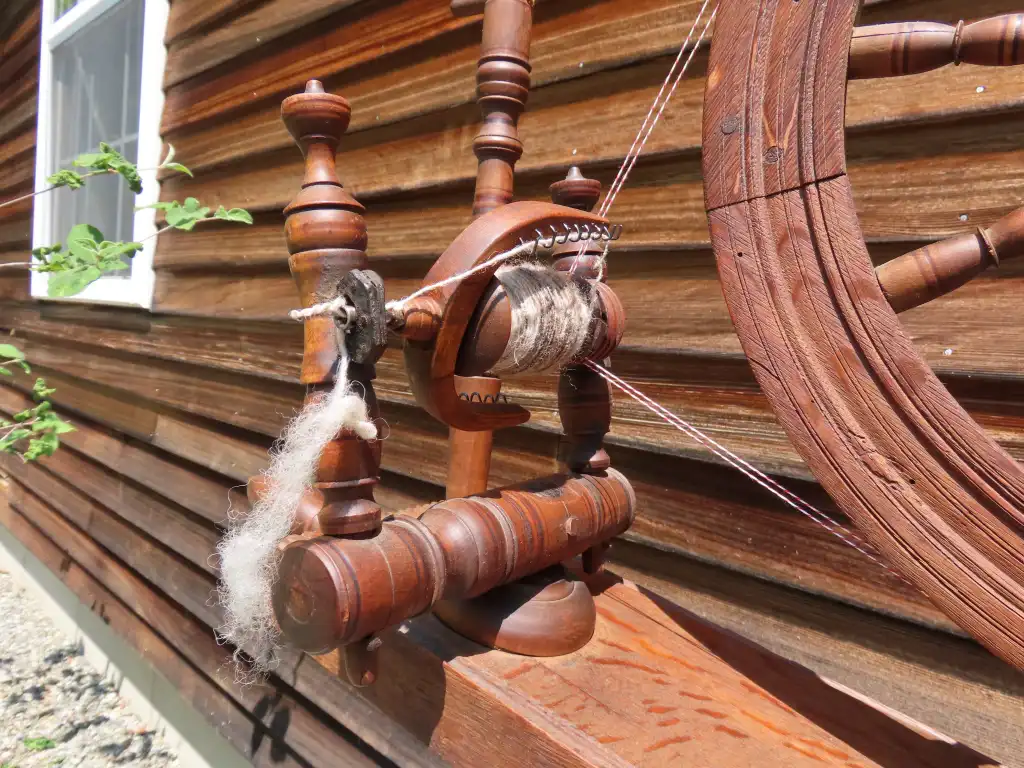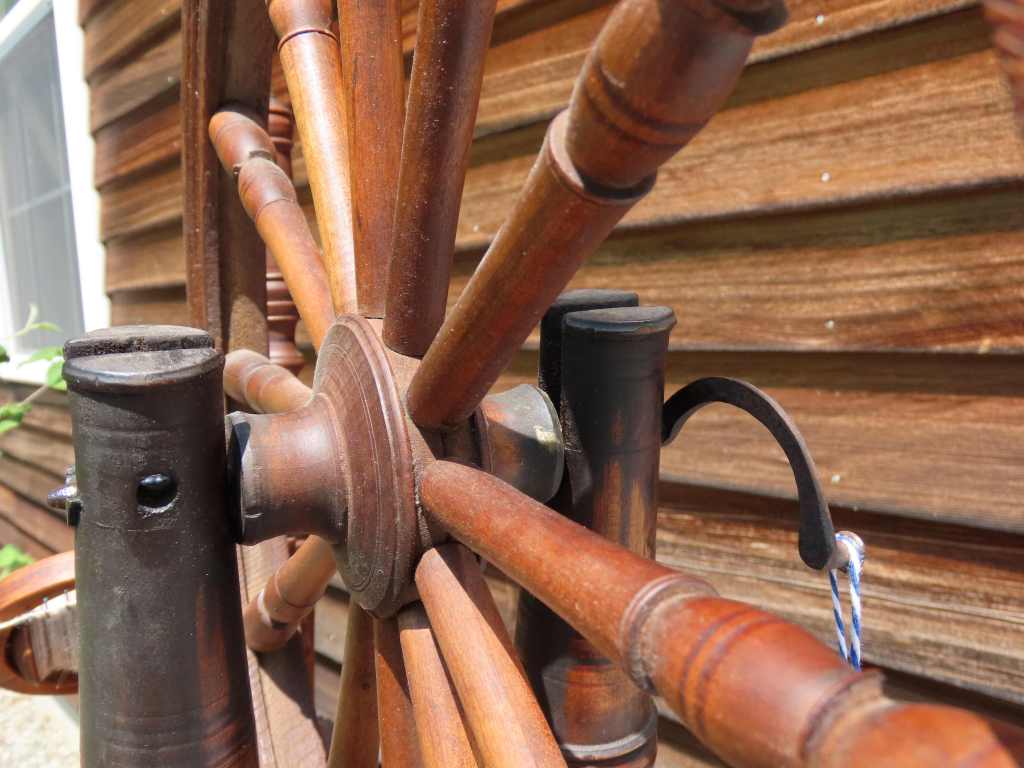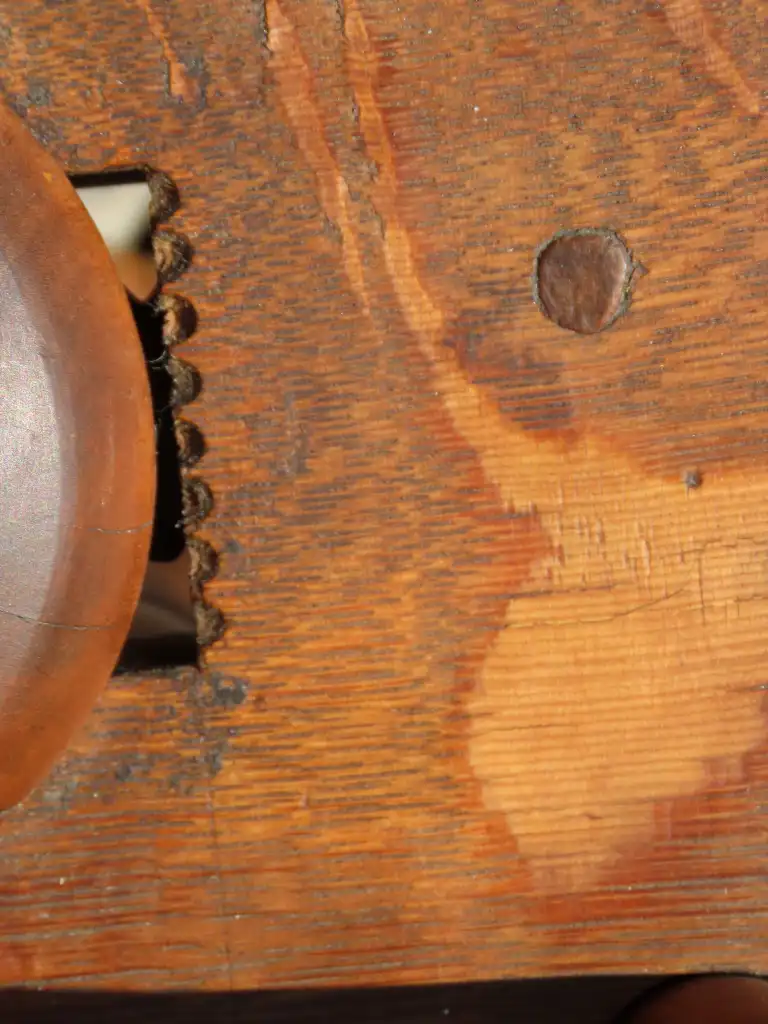
This wheel is intriguing. It is marked with the initials “IAM” and the date “1827.”

Yet, as far as I know, the maker has not been identified. According to the list of spinning wheel makers in Pennington and Taylor’s book, several flax wheels with the “IAM” mark have been found in Pennsylvania and Ohio, with dates of 1825, 1834, and 1843.

To complicate matters, a friend has a wheel with a very similar “IAM” mark and a date of 1833, but the wheel itself bears little resemblance to this one. That wheel turned up in Virginia. This one belonged to New Hampshire collector, Sue Burns, but I have no idea where she found it originally.

When I started researching, I hoped the mark at the other end of the table, “P. Wealand”–most likely the wheel’s owner–might provide a clue.

I found numerous Wealand families in Pennsylvania and Ohio in 1827, but not many first names beginning with “P.” Probably the strongest candidate was a Polly Wealand born in 1810 in Lancaster, Pennsylvania. She would have been 17 when this wheel was made, so the timeline fits nicely for the wheel to be made as a present to her, possibly for an engagement or wedding.

But I could not find any evidence of a Lancaster wheel maker in 1827 with the initials IAM or JAM. I found a John McSorley, listed as a spinning wheel maker in East Lampeter, Lancaster, PA in the 1850 census, but his age was only 36—too young to have been making wheels in 1827. I could not track down his family to see if he had a wheel-making brother or father. James Murry was another possibility. He was listed as a wheel wright in Stroudsburg, PA in the 1860 census, but he was not that close to Lancaster and there was no concrete evidence that he made spinning wheels.

I focused my research mostly on Pennsylvania, rather than Ohio, because so many of the wheel’s features are found in other Pennsylvania wheels. What is interesting, though, is that it resembles wheels in several different eastern Pennsylvania counties.

For example, it has a few notable similarities with the wheels made by J. Fox (Jacob Fuchs) (see previous post “Ester”) in Berks County. The way the the uprights below the table are turned and striped is much like the Fox wheels.

And, as with the Fox wheels, this wheel has a hole for a reeling pin, which suggests either Berks or a nearby county, where this somewhat unusual feature was most often found.

The drive wheel is so similar to Fox’s that, at first, I thought it might be a replacement off of a Fox wheel.

The unusual hub design, with snouts on both sides, is very similar

and, like Fox wheels, the rim is built radially in four equal parts and double pegged at the joints.

The spokes are much the same.

But there are differences in construction,

turnings, decoration,

and the axle is more curved than the axle on my Fox wheel.

Also, the wood, aging, fit, grease stains, and overall look just seem to indicate that it is original to this wheel. Nevertheless, that there is some Fox influence seems pretty apparent.

On the other hand, the style of maker’s mark differs from Fox. Here, the initials and a date were picked with a sharp tool, likely an awl, into the table’s end grain rather than stamped. This style mark is similar to Abraham Overholt’s (from Bucks County) and William Major’s (from Chester County). (P & T at 124-25)

Also similar to Overholt and Major, this wheel has decorative stamping along with the P. Wealand name. (I did research to see whether Major had a wheel making brother with an “I” or “J” first name, but came up empty-handed.)

The turnings on the spokes and the flat-topped finials on the maidens and distaff

are also similar to Overholt’s wheels and to a group of other Bucks County makers, including D. Reiner, S. Reiner, I. Sellers, and I. Homsher. (P&T at 124-25).

Those wheel makers, however, constructed the secondary upright supports to extend down to the legs, which is different than this wheel, where they only go to the table.

In fact, although this wheel is much smaller, the profile looks very much like my Irish wheel (see previous post “Handsome Molly”), with the double secondary supports holding the drive wheel in a very upright position quite close to the flyer assembly.

Although I searched in Berks, Bucks, Chester, Montgomery, and Lancaster counties, I could not come up with evidence of an IAM wheel maker in 1827. I hope there are enough clues to eventually lead us to this wheel’s maker. If so, it may give us a better understanding of the relationships between wheel makers in the area and how IAM and P. Wealand fit into their particular time and place.

Whoever IAM was, he made a lovely wheel, highlighting the ray flecks in the table’s wood so that over two hundred years later, I appreciate the way they pop in the light every time I spin.

The wheel is beautifully constructed, with thoughtful decorative touches such as the chip carving,

punched designs, burned ring marks,

and pleasing turnings.

The grease stains show that the wheel was well used.

While the upper two parts of the distaff are gone, I am delighted that this part survived.

Sadly, the original flyer arms must have broken at some point. The mandrel appears to be original and perhaps the bobbin, but the clunky flyer arms seemed to be a fairly recent replacement,

so I had new ones made.

The treadle bars had some damage too (I actually broke one when I first spun on the wheel).

I repaired the treadle and with her new flyer arms, it is pure pleasure to spin on this wheel.

References:
Pennington, David and Taylor, Michael, Spinning Wheels and Accessories, Schiffer Publishing, Atglen, PA 2004, pp. 123-29.
ancestry.com for genealogical research and census records

As far as the P. Wealand name, people with the name Margaret, often have the nickname of Peggy. Thus, the P Wealand. Just a thought.
LikeLike
Excellent point! And Polly sometimes is a nickname for Mary, so I should be searching for Margarets and Marys, too. Also, the name “Wealand” is spelled various ways on different documents so there are endless research trails on this one. I realize that finding the owner with any degree of certainty is hugely unlikely. But was hoping that finding some possible owners might help to narrow the search geographically for the maker. There is a lot more research to be done on this one! Thanks.
LikeLike
Thanks for all the details. It was awesome to see someone else have a similar wheel by the same maker, mine is dated 1821. There is no name on the other end. Amazing how functional and smooth these spin over 200 years later!
I located mine in an antique shop in Loudon TN. The owner stated she bought it at an auction.
The wheel had missing parts
1) Footman- we created a temporary one until my husband can make a better one
2) most important parts – flyer, bobbin, and whorl. I really lucked out here. Purchased via Etsy a set that fitted perfectly from Lithuania.
3) back maiden part to hold flyer, I made from leather.
4) missing 2 distaff parts, doubt I will replace these
After fixing / adding parts, cleaning, & oiling she is spinning again!
Thanks so much for these details. I will be spinning yarn soon. I will cherish this wheel and hopefully it will become an heirloom in my family!
LikeLike
Yours is the only other one I’ve seen, so I’m glad that you posted her on FB and Rav. And even more delighted that you got her spinning again. Too bad we don’t know more about the maker, but perhaps another wheel will turn up eventually to shed more light on who he is!
LikeLike